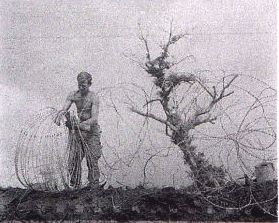The Answer is "Don't Fence Me In".
The question is "What are these men singing?"
Concertina Wire was not yet an item of supply. Barbed wire
had been invented in the USA and patented by Joseph Glidden in 1874. It was
used to construct protective fences by US troops in the Spanish American
War. By the 1900s the military use of barbed wire was common. Each side used
different patterns for their fences, the US Army manual described over six
different ways to employ barbed wire. Foot traps (tanglefoot), vertical
fences, single and double apron fences, single and multiple rounds, the list
goes on. In each case single strands of wire were stretched from support to
support and attached or tied off. In all cases a principal ingredient was
muscle power and sweat.
In this picture Engineers supervise, and take the credit, while the
hammer and nail work is done by, you guessed it, line troopers. Notice the
round hoops or spacers being installed between the strands of wire. When
the fence is complete the wooden beams will be removed to preclude
their use as crossing aids.
 As time passed the use of wire continued but not in the formal manner once
seen. German razor tape and concertina wire replaced strands of barbwire.
In Vietnam it was used to slow or channel enemy attacks and was placed out
in loose rolls, one, two or three layers high. These stacks were not fences,
rather they were obstacles and covered with preplanned direct fire. When the
unit moved the wire was taken up and moved with the unit to be used again.
As time passed the use of wire continued but not in the formal manner once
seen. German razor tape and concertina wire replaced strands of barbwire.
In Vietnam it was used to slow or channel enemy attacks and was placed out
in loose rolls, one, two or three layers high. These stacks were not fences,
rather they were obstacles and covered with preplanned direct fire. When the
unit moved the wire was taken up and moved with the unit to be used again.

[RETURN to TEXT]
[APPENDICES]
[INDEX]


